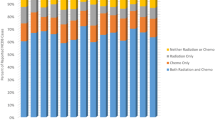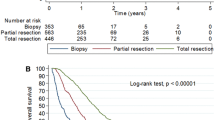Abstract
Survival outcomes and patterns of care for brain tumor patients in the USA Veterans population have not been previously published and the extent of variation in outcomes between Veterans and the rest of the USA is currently unknown. The Veterans healthcare administration (VA) provides comprehensive care to Veterans and their families and maintains the Veterans affairs central cancer registry (VACCR). This was a retrospective review of microscopically-confirmed, supratentorial glioblastoma multiforme in male Veterans actively followed by the VACCR; survival was analyzed and compared to a national cohort from the surveillance, epidemiology and end results program. We analyzed 1,219 Veterans with glioblastomas diagnosed between 1997 and 2006. Median survival was 6.5 months and 1, 2, and 5 years survival rates were 26.8, 5.4, and 0.5%, respectively. Patients receiving all three treatment modalities (surgical resection, radiotherapy, and chemotherapy) did best; these findings remained true among patients aged 70 and older such that these patients had an overall survival similar to those age <70. A comparable national cohort had longer median survival (9.0 months) and greater 1, 2, and 5 years survival rates (37.8, 12.8, and 4.1%) than the VA cohort. Survival and patterns of care are presented for the first time for Veterans with glioblastoma multiforme. In conclusion, we found that more aggressive therapy was associated with better survival, even among elderly Veterans and whether compared overall or by age group, VA patients showed decreased survival relative to a national cohort. We believe this potential disparity warrants further investigation.


Similar content being viewed by others
References
DeAngelis LM (2001) Brain tumors. N Engl J Med 344(2):114–123
El-Zein R, Bondy M, Wrensch M (2005) Epidemiology of brain tumors. In: Ali-Osman F (ed) Brain tumors. Humana Press, New Jersey, pp 3–14
CBTRUS 2007–2008. Primary brain tumors in the United States Statistical report 2000–2004. Central brain tumor registry of the United States
Louis DN, Ohgaki H, Wiestler OD, Cavenee WK (2007) World Health Organization classification of tumors of the central nervous system. IARC Press, Lyon
Wen PY, Keari S (2008) Malignant gliomas in adults. N Engl J Med 359:492–507
Olson JJ, Fadul CE, Brat DJ, Mukundan S, Ryken TC (2009) Management of newly diagnosed glioblastoma: guidelines development, value and application. J Neurooncol 93(1):1–23
Stupp R, Mason WP, van den Bent MJ et al (2005) Radiotherapy plus concomitant and adjuvant temozolomide for glioblastoma. N Engl J Med 352:987–996
US Census Bureau, Population Division. Available at. http://www.census.gov/popest/estimates.html. Accessed 15 June 2010
Komrokji RS, Matacia-Murphy GM, Al Ali NH et al (2010) Outcome of patients with myelodysplastic syndromes in the Veterans administration population. Leuk Res 34(1):59–62
Cairncross J, Macdonald D, Ludwin S et al (1994) Chemotherapy for anaplastic oligodendroglioma. J Clin Oncol 12:2013–2021
Selim AJ, Kazis LE, Qian S et al (2009) Differences in risk-adjusted mortality between medicaid-eligible patients enrolled in medicare advantage plans and those enrolled in the veterans health administration. J Ambul Care Manage 32(3):232–240
Kazis LE, Miller DR, Skinner KM et al (2006) Applications of methodologies of the Veterans health study in the VA healthcare system: conclusions and summary. J Ambul Care Manage 29(2):182–188
Weaver F, Hynes D, Hopkinson W, Wixson R, Khuri S, Daley J, Henderson WG (2003) Preoperative risks and outcomes of hip and knee arthroplasty in the Veterans health administration. J Arthroplasty 18(6):693–708
Fleming C, Fisher ES, Chang CH, Bubolz TA, Malenka DJ (1992) Studying outcomes and hospital utilization in the elderly. The advantages of a merged data base for Medicare and Veterans affairs hospitals. Med Care 30(5):377–391
Surveillance, Epidemiology, and End Results (SEER) Program (http://www.seer.cancer.gov) SEER*Stat Database: incidence—SEER 17 Regs Research Data + Hurricane Katrina Impacted Louisiana Cases, Nov 2009 Sub (1973–2007 varying)—Linked To County Attributes—Total USA, 1969–2007 Countries, National Cancer Institute, DCCPS, Surveillance Research Program, Cancer Statistics Branch, released April 2010, based on the November 2009 submission
Ihaka R, Gentleman R (1996) R: a language for data analysis and graphics. J Comput Graph Stat 5(3):299–314
Filippini G, Falcone C, Boiardi A et al (2008) Prognostic factors for survival in 676 consecutive patients with newly diagnosed primary glioblastoma. Neuro Oncol 10(1):79–87
Vuorinen V, Hinkka S, Farkkila M, Jaaskelainen J (2003) Debulking or biopsy of malignant glioma in elderly people—a randomised study. Acta Neurochir 145(1):5–10
Brandes AA, Vastola F, Basso U et al (2003) A prospective study on glioblastoma in the elderly. Cancer 97(3):657–662
Keime-Guibert F, Chinot O, Taillandier L et al (2007) Radiotherapy for glioblastoma in the elderly. N Engl J Med 356(15):1527–1535
Marijnen CA, van den Berg SM, van Duinen SG, Voormolen JH, Noordijk EM (2005) Radiotherapy is effective in patients with glioblastoma multiforme with a limited prognosis and in patients above 70 years of age: a retrospective single institution analysis. Radiother Oncol 75(2):210–216
Mukerji N, Rodrigues D, Hendry G, Dunlop PR, Warburton F, Kane PJ (2008) Treating high grade gliomas in the elderly: the end of ageism? J Neurooncol 86(3):329–336
Scoccianti S, Magrini SM, Ricardi U et al (2010) Patterns of care and survival in a retrospective analysis of 1059 patients with glioblastoma multiforme treated between 2002 and 2007: a multicenter study by the central nervous system study group of Airo (Italian association of radiation oncology). Neurosurgery 67(2):446–458
Laws ER, Parney IF, Huang W et al (2003) Survival following surgery and prognostic factors for recently diagnosed malignant glioma: data from the glioma outcomes project. J Neurosurg 99(3):467–473
Karnofsky DA, Burchenal JH (1949) The clinical evaluation of chemotherapeutic agents in cancer. In: MacLeod CM (ed) Evaluation of chemotherapeutic agents. Columbia Univ Press, New York, p 196
Rabeneck L, Souchek J, El-Serag HB (2003) Survival of colorectal cancer patients hospitalized in the veterans affairs health care system. Am J Gastroenterol 98(5):1186–1192
Campling BG, Hwang WT, Zhang J et al (2005) A population-based study of lung carcinoma in Pennsylvania: comparison of veterans administration and civilian populations. Cancer 104(4):833–840
Zeliadt SB, Sekaran NK, Slatore CG et al (2010) Comparison of the veterans affairs oncology registry and the seer cancer registry among patients with lung cancer. J Clin Oncol 28:15 Abstr 6056
Bilimoria KY, Bentrem DJ, Tomlinson JS et al (2007) Quality of pancreatic cancer care at veterans administration compared with non-veterans administration hospitals. Am J Surg 194(5):588–593
Rosenthal MA, Drummond KJ, Dally M et al (2006) Management of glioma in victoria (1998–2000): retrospective cohort study. Med J Aust 184(6):270–273
Schwartzbaum JA, Fisher JL, Aldape KD, Wrensch M (2006) Epidemiology and molecular pathology of glioma. Nat Clin Pract Neurol 2(9):494–503
Ohgaki H, Kleihues P (2005) Epidemiology and etiology of gliomas. Acta Neuropathol 109(1):93–108
Chaichana K, Parker S, Olivi A, Quiñones-Hinojosa A (2010) A proposed classification system that projects outcomes based on preoperative variables for adult patients with glioblastoma multiforme. J Neurosurg 112(5):997–1004
Singh JA, Sloan J (2009) Higher comorbidity, poor functional status and higher health care utilization in veterans with prevalent total knee arthroplasty or total hip arthroplasty. Clin Rheumatol 28(9):1025–1033
Mauer ME, Taphoorn MJ, Bottomley A et al (2007) Prognostic value of health-related quality-of-life data in predicting survival in patients with anaplastic oligodendrogliomas, from a phase III EORTC brain cancer group study. J Clin Oncol 25(36):5731–5737
Author information
Authors and Affiliations
Corresponding author
Rights and permissions
About this article
Cite this article
Arrigo, R.T., Boakye, M. & Skirboll, S.L. Patterns of care and survival for glioblastoma patients in the Veterans population. J Neurooncol 106, 627–635 (2012). https://doi.org/10.1007/s11060-011-0702-6
Received:
Accepted:
Published:
Issue Date:
DOI: https://doi.org/10.1007/s11060-011-0702-6




